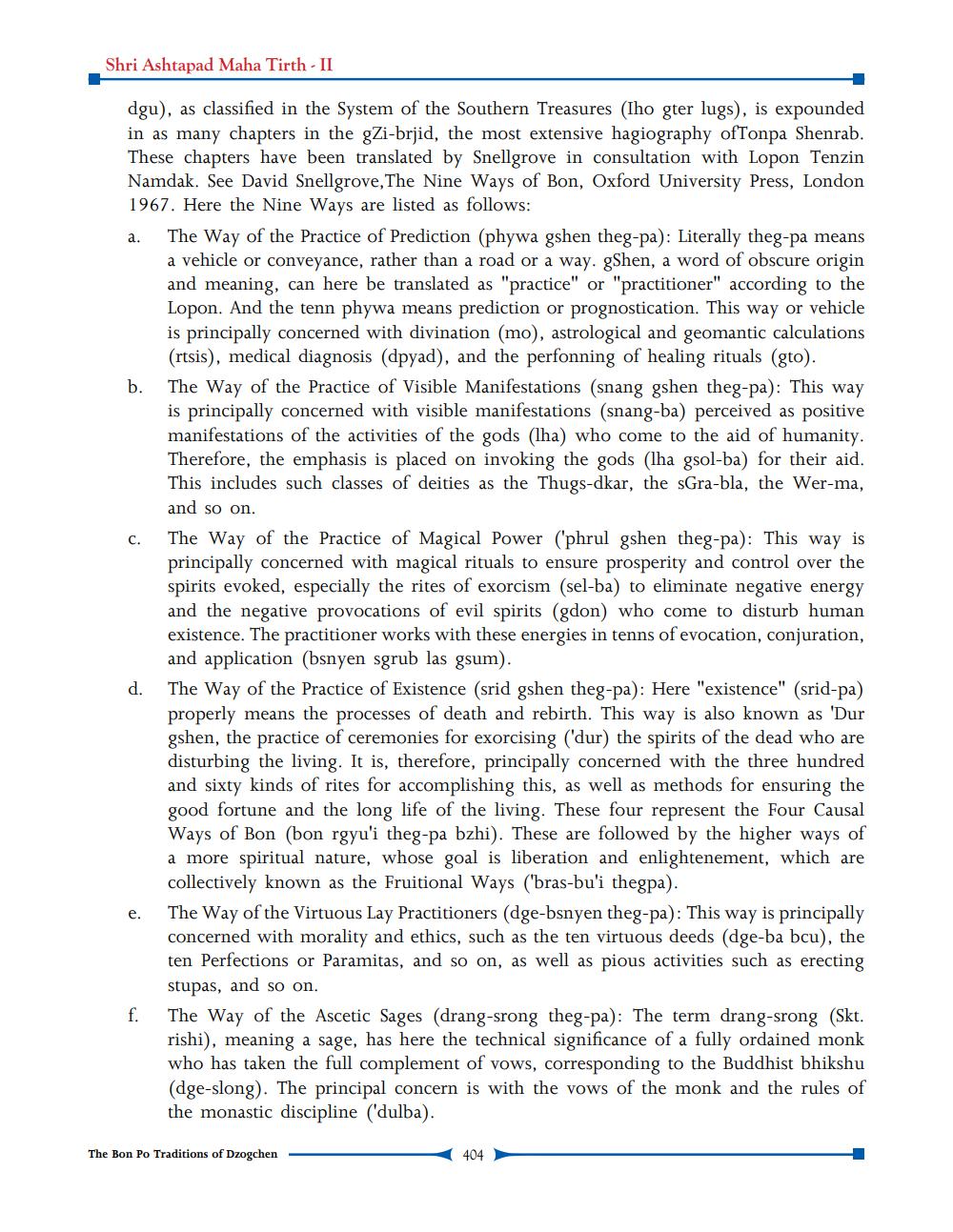________________
Shri Ashtapad Maha Tirth - II
b.
dgu), as classified in the System of the Southern Treasures (Iho gter lugs), is expounded in as many chapters in the gZi-brjid, the most extensive hagiography ofTonpa Shenrab. These chapters have been translated by Snellgrove in consultation with Lopon Tenzin Namdak. See David Snellgrove, The Nine Ways of Bon, Oxford University Press, London 1967. Here the Nine Ways are listed as follows: a. The Way of the Practice of Prediction (phywa gshen theg-pa): Literally theg-pa means
a vehicle or conveyance, rather than a road or a way. gShen, a word of obscure origin and meaning, can here be translated as "practice" or "practitioner" according to the Lopon. And the tenn phywa means prediction or prognostication. This way or vehicle is principally concerned with divination (mo), astrological and geomantic calculations (rtsis), medical diagnosis (dpyad), and the perfonning of healing rituals (gto). The Way of the Practice of Visible Manifestations (snang gshen theg-pa): This way is principally concerned with visible manifestations (snang-ba) perceived as positive manifestations of the activities of the gods (lha) who come to the aid of humanity. Therefore, the emphasis is placed on invoking the gods (lha gsol-ba) for their aid. This includes such classes of deities as the Thugs-dkar, the sGra-bla, the Wer-ma, and so on. The Way of the Practice of Magical Power ('phrul gshen theg-pa): This way is principally concerned with magical rituals to ensure prosperity and control over the spirits evoked, especially the rites of exorcism (sel-ba) to eliminate negative energy and the negative provocations of evil spirits (gdon) who come to disturb human existence. The practitioner works with these energies in tenns of evocation, conjuration,
and application (bsnyen sgrub las gsum). d. The Way of the Practice of Existence (srid gshen theg-pa): Here "existence" (srid-pa)
properly means the processes of death and rebirth. This way is also known as 'Dur gshen, the practice of ceremonies for exorcising ('dur) the spirits of the dead who are disturbing the living. It is, therefore, principally concerned with the three hundred and sixty kinds of rites for accomplishing this, as well as methods for ensuring the good fortune and the long life of the living. These four represent the Four Causal Ways of Bon (bon rgyu'i theg-pa bzhi). These are followed by the higher ways of a more spiritual nature, whose goal is liberation and enlightenement, which are
collectively known as the Fruitional Ways ("bras-bu'i thegpa). e. The Way of the Virtuous Lay Practitioners (dge-bsnyen theg-pa): This way is principally
concerned with morality and ethics, such as the ten virtuous deeds (dge-ba bcu), the ten Perfections or Paramitas, and so on, as well as pious activities such as erecting
stupas, and so on. f. The Way of the Ascetic Sages (drang-srong theg-pa): The term drang-srong (Skt.
rishi), meaning a sage, has here the technical significance of a fully ordained monk who has taken the full complement of vows, corresponding to the Buddhist bhikshu (dge-slong). The principal concern is with the vows of the monk and the rules of the monastic discipline ('dulba).
The Bon Po Traditions of Dzogchen
(404




